
The Matchbox Diary
Written by Paul Fleischman
Illustrated by Bagram Ibatoulline
Candlewick Press, 2013, 40 pp.
ISBN: 9780763646011
A little girl visits her great-grandfather who shares his immigrant journey through a collection of curio matchboxes. Each matchbox contains an artifact of a remembrance of his life since leaving Italy in the early of 1900s. All of the artifacts, from the olive pit to the printing press letters, tell of the family’s poignant immigrant life. The aspiration of being literate and great-grandfather’s devotion to family are themes imbued throughout the matchbox stories. The illustrations show warm vintage expressions using acrylic gouache. Remembrance and reality are juxtaposed with the sepia and amber tones in coloration. The elaborate drawing of artifacts takes readers to a museum of the 1900s. Detailed facial expressions capture and convey characters’ emotion.
The socio-economic context of the immigrant family is naturally incorporated. When great-grandfather’s family arrived in New York, they worked at a cannery and kept doing piecework, moving from place to place, alienated by social discrimination. The illustration reveals them as powerless with all of the family looking down and father’s gaze looking up in resistance. Fleischman’s metaphors of hairpins and fish scales represent the gap between their hope and reality. Fleischman’s text says that on the ship “high above us were rich ladies” and “we were in the bottom”, but “I thought my mother and sisters would look like those women soon.” However, “instead of jewels, my mother and sisters had fish scales on their arms.” Ibatoulline’s illustration enhances this reality by showing the contrast dividing the upper and lower deck, and depicting the great-grandfather as a boy holding a pole extended to the upper deck.
Paul Fleishman intertwined what is typical for those times into the story, saying that “I thought about teaching history as a career, but decided to bring it into my books instead.” One of vignettes presented in the story is visiting a ballpark to watch a baseball game, popular in the early 1900s. Great-grandfather found his career as a printer, which was a job that played an important role in the labor movement. The illustration shows a piece of newspaper with the exact date of August 23, 1916. Students, both from an immigrant family or native-born family, might be invited by this story to inquire into the U.S. history of those times and how the historical events influenced the lives of ordinary people.
Even though this story is told by an adult of his experiences, it does not fail to include the perspective of a child. Great-grandfather “had nightmares about buttonhook man”, being terrified by the buttonhook inspection at the immigrant quarantine. Ibatoullin’s illustrations significantly juxtapose the sharp contrast of children’s nature. On one page great-grandfather as a little boy is portrayed as being powerlessly horrified by the inspector. In contrast, on the opposite page, the great-granddaughter is drawn with eyes full of strong confidence.
Paul Fleischman won the 1989 Newbery Medal for Joyful Noise: Poems for Two Voices. He grew up in a literary family listening to his father read aloud his own books. His father, Sid, is also a Newbery winner for The Whipping Boy in 1987. Paul said in an interview that “I work entirely off my own enthusiasms and pay no attention to the market”, and “I write because I have a need to build.” He lives his life following his own passion, rather than pursuing a famous career. Bagram Ibatoulline crafted breathtaking, detailed illustrations. He was born in Russia and studied art in Moscow. His art is based on a solid art education started at the age of ten. To get inspiration and create the style of illustration, Ibatoulline does extensive research and opens his heart to the text.
In the classroom many learning activities can be implemented by using this book. One suggestion is to build a chronological table of students’ parents or ancestors who were the first generation of immigrants to a particular place. While doing so, students will come to know that immigration is a common theme and have a chance to investigate the immigration issue in the broad global context. Reading this book with In the New World (Christa Holtei, 2015), a German immigration story told over generations, can introduce students to the perspective of seeing immigration as a valuable journey for their family. Grandfather’s Journey (Allen Say, 1993) is an older book that shares the experiences of family members who immigrated. Students will be able to have a chance to share and respect the immigrant experiences of their ancestors and their struggles to overcome adverse circumstances in the early stages of globalism, both in their homeland and in their new land.
Hee Young Kim, University of Arizona, Tucson, AZ
WOW Review, Volume VII, Issue 4 by Worlds of Words is licensed under a Creative Commons Attribution-NonCommercial-ShareAlike 4.0 International License. Based on work at https://wowlit.org/on-line-publications/review/vii-4/
